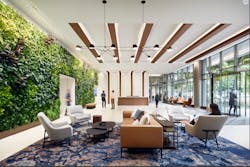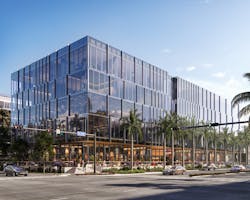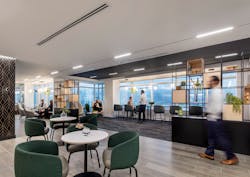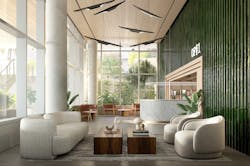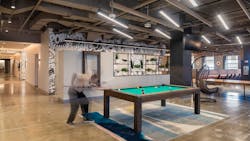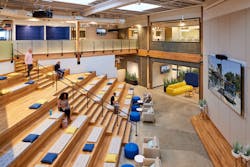Commercial Office Space Must Evolve to Put People First
As the global pandemic recedes into the proverbial rearview mirror, what’s ahead for the workplace is coming into sharper focus—and it isn’t quite as dire as some have predicted.
“We’re really in the same place that we always have been. I think people are just looking at it differently,” said Sara Ross, principal at Dyer Brown. “The office is here to stay; the office is not dying. I’m sure some people think it might be, but it’s not.”
Rather, it’s evolving into a destination where employees can have experiences they can’t find at home—a place where they can collaborate creatively, revive in-person connections with coworkers and take advantage of technology and amenities that offices afford them. And for all the hype around the hybrid workplace model, what it ultimately offers people—whether they’re in the office one day a week or all five—is “the opportunity for us to actually do what we’ve been talking about for over a decade–make work more human,” according to a recent Steelcase global report, The New Era of Hybrid Work.
We spoke to several design and development professionals to find out what’s driving commercial office real estate today and, more importantly, how to make it more people-centric.
Office Space: What’s Happening and Why
In the Portland market, Mikkelsen says her firm is still witnessing widespread vacancies throughout the central business district—specifically, more vacancies in Class A office spaces versus Class B and C. She adds that speculative office development has slowed over the past five years, helping to stabilize the market to some extent.
“We have seen some spaces being repurposed, for example, corporate offices turned into coworking spaces, and of course a lot of discussion about turning office buildings into housing,” Mikkelsen observed. “However, the high cost of turning office buildings into residential buildings has kept most developers from pursuing this project type.”
At the opposite end of the country in Miami, vacancy rates continue to decline as demand for Class A office space remains high, unlike in more challenging markets like New York or Chicago, said David Martin, CEO of Miami-based development firm Terra. “Florida’s year-round sunshine and lower taxes continue to draw businesses and consumers to Miami, creating demand for Class A office space. We continue to see a wave of new-to-market tenants in Miami and expect this trend to continue,” he said.
Ross notes that the repurposing of space on the tenant side of the equation is about shifting ratios in the wake of the pandemic. Whereas in the past, employees may have come into the office to do 50% heads-down work and 50% collaborative work, those numbers are skewing higher toward increased collaboration, depending on the client.
Ultimately, she says it’s important for clients to understand why people are coming to the office and create environments that support those activities. “It’s about, what do you want people to do when they come in? Engaging employees for culture reasons, development in person, mentoring, face-to-face communication, training or onboarding like we’re seeing,” Ross said. “We ask clients like these types of questions so that that we can build their program [accordingly.]”
What’s driving these trends is the fact that collaboration, culture and even careers can only grow so much within a grid on the screen, Mikkelsen pointed out. “People need physical places and spaces to thrive. While it is tempting to think that a magic combination of amenities and incentives will encourage employees to return to the office, a more sustainable approach asks, ‘How can we cultivate an ecosystem of engaged, motivated, successful employees in our office and beyond?’ This kind of ‘ecosystem thinking,’ as we like to call it at Ankrom, looks at the workplace as an interconnected environment, where the wellbeing of one lifts the prospects of all.”
Employees Expect Wellness at Work
“To meet the needs of employees’ work expectations today, companies are prioritizing health and wellness in the workplace through curated programming and amenities, and seeking office space that caters to these needs,” he said.
Mikkelsen goes so far as to say, “I don’t think we can even talk about the workplace without talking about wellness.”
Beyond offering yoga classes or meditation rooms, she notes that “a well-rounded workplace wellness program should include benefits that address workers’ mental health, physical health, financial health, intellectual health, growth and purpose. When a company provides services to address all those aspects, they help their employees do their best work,” Mikkelsen added.
“Creating a culture of workplace wellness starts with nutrition, physical activity, communication, coaching and stress management,” Martin explained. “The Offices at The WELL Bay Harbor Islands address each aspect of workplace well-being providing companies all the tools required to promote an optimal environment for sustainable, overall health and wellness.”
At Dyer Brown, designing for sustainability and employee wellness is a baseline objective for the firm and will implement these strategies at low or no additional cost to the client’s budget. More importantly, however, she says the firm is taking things a step further toward greater equity by asking how the products they source impact the health of the people who are manufacturing them at the end of the supply chain.
“There’s a lot of forced labor in the construction and AEC industry, so this is a way for us to be asking questions like, ‘Where is that wellness for the people who are sourcing our products?’” she said.
Amenities Matter
According to Mikkelsen, employees are also craving office spaces and amenities that meet both their professional and personal needs. “More than just a place to work, many workplaces have become an extension of one’s home and provide some of the same comforts such as common areas with comfortable chairs and natural light, outdoor spaces and quiet spaces,” she said. In addition, Mikkelsen noted that amenity-rich office spaces that prioritize employees’ physical and mental health, and office designs that cater to employees’ well-being are critical.
The Future Is People-Centric
She suggests offices should be designed so that every person that enters the space knows that they are the intended occupant—“that the space was designed for them, and that they are empowered to bring 100% of themselves. Whether it be an employee, a guest, an interviewee or a strategic partner, the experience in the office should be empowering for all capabilities, all genders, all sizes and all cultures.
A few of the ways the team at Ankrom Moisan designs for inclusivity for its clients is to:
- Minimize distractions in the workplace with softer color palettes and indirect lighting
- Bring accessibility forward, so it’s not a ramp or low counter around the corner; it’s celebrated and right there for everyone
- Provide spaces to suit employees’ needs throughout the day. “Every day brings ever-changing demands, and our workplaces need to provide opportunities for heads-down focused time at one part of the day and robust collaboration at another,” she said.
Office buildings today should be designed to ensure that everything employees want and need to boost their productivity is available, according to Martin. Function, ease and curated amenities should all be factored into workplace design to help entice employees to leave the comforts of their home office and head back into work, he added.
“Building owners that create office spaces to help enhance the employee experience will win out in the end,” Martin said. “Custom-designed and flexible office spaces to fit a variety of needs, curated wellness and lifestyle amenities, access to ample outdoor space and access to physical and mental health programming are key ingredients to creating successful workplaces of the future.”
5 Shifts in Workplace Design
1. The Office Gets Personal. People-first design doesn’t have to mean a complete overhaul of your office. Every small step matters. For example, a reception desk that is designed with accessibility as the baseline, rather than as an alternative experience. Specifying office furnishings and fixtures with a variety of body types and sizes in mind. Or incorporating neuro-inclusive elements that create a more comfortable visual and tactile environment, such as chairs that gently rock and swivel, or quiet zones, designed with a calming palette, softer textures and sound-absorbent materials.
2. The Commute-Worthy Workplace. The new commute-worthy workplace takes human connection seriously and prioritizes the experience of working with others over the seclusion of home. Instead of one central spot, connection and communication are integrated into the workday and woven throughout the workplace. Collaboration spaces are central within each floor or department, as are large group activity spaces and smaller seating groups. Desks are grouped for collaboration and interaction, and barriers are minimized.
3. The Not-so-Office Office. Where once we saw bright colors, slick surfaces and highly branded environmental graphics, we are now seeing environments that are intuitive, nurturing and inclusive. Think inviting hotel lobbies, comforting casual restaurants and residential living rooms. These not-so-office environments build in seamless function as baseline amenities, prioritizing the emotional experience of the employee and the communal experience of the ecosystem as the true goal.
4. New Ways to Meet. With the move to hybrid work, companies have had an opportunity to consider how meetings can actually be additive to the ecosystem, driving productivity, satisfaction and investment in the great good among those in attendance. We are now looking at reconfiguring table layouts to accommodate both in-person and hybrid meetings, camera-friendly backdrops, specifying non-glare surfaces, and planning ahead for meetings in the metaverse, with VR capabilities designed into conference rooms.
5. Culture-first Employee Engagement. Culture-led workplace design prioritizes the everyday experience of culture over the offsite or occasional company event. For example, if transparency is valued, executive offices and conference rooms should be easily seen and accessed by employees at all levels. For companies with an authentic sustainability focus, design should transcend eco-friendly materials and sustainability/wellness certifications, and encourage earth-friendly employee behaviors, such as energy and resource conservation.
